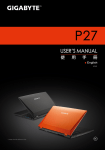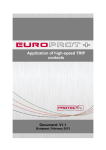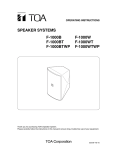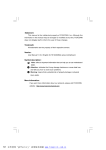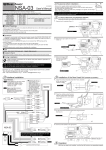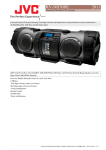Download Sony CHC-P33D User's Manual
Transcript
3-856-227-12(1) Mini Hi-Fi Component System Operating Instructions CHC-P33D © 1996 by Sony Corporation Chapter 1: Setting Up Connecting the Stereo AM loop aerial connection Connect the supplied loop aerial to the AM and the y terminals. Connecting the Stereo Use the illustrations below to connect your stereo. If you want to connect any optional components to the stereo, see “Connecting Optional Equipment” in Chapter 6. STEP 1 Connecting the Speakers Installing the Speakers Inserting the Batteries Setting the Clock To improve the FM reception Connect an outdoor FM aerial to the FM 75Ω terminal, using a 75-ohm coaxial cable and IEC standard socket connector. For speakers installation, see “Installing the Speakers”. Right (R) and Left (L) satellite speakers Connect the right speaker to the R connectors and the left speaker to the L connectors. Connect the grey cords with white stripes to ‘ and the solid grey cords to ’. FM 75Ω AM IEC standard socket connector (not supplied) ‘ R ‘ ’ ’ L Superwoofer Connect the superwoofer to the WOOFER connectors. Connect the grey cord with red stripes to ‘ and the solid grey cord to ’. ’ To improve the AM reception After you connect the AM aerial, connect a 6- to 15-meter (20- to 50- feet) insulated wire to the AM terminal. Connect the y terminal to earth. Important Ground the external aerial from y terminal against lightning. To prevent a gas explosion, do not connect the ground wire to a gas pipe. ‘ FM 75Ω AM STEP 2 Connecting the Aerials FM lead aerial (supplied)* FM 75Ω AM AM loop aerial (supplied) * Note: Extend horizontally 4 Chapter 1: Setting up Insulated wires (not supplied) Ground wire (not supplied) Right satellite speaker Superwoofer AM loop aerial Left satellite speaker FM lead aerial STEP 2 STEP 1 STEP 3 to a wall outlet Do this connection last! STEP 3 Connecting the Power Connect the mains lead to a wall outlet after you have made all the above connections. Note Do not install the woofer close to the unit, and do not place the woofer above or below the unit. Otherwise, the vibration from the woofer may cause mechanical noise or “skipping”. When installing the speakers on either side of the main unit Place the woofer between the two satellite speakers. + = to a wall outlet When installing the satellite speakers away from each other Position the satellite speakers so they face toward your listening position. When installing the satellite speakers away the woofer 1 Insert the supplied stand into the rear of the woofer. Installing the Speakers Proper speaker positioning is essential in order to achieve directional effects and diffused ambiance. When you install the speakers, refer to the following instructions. Once you have determined the final placement, fasten the speakers to the speaker stands. continue to next page ➔ 2 Install the woofer between the satellite speakers with its front panel facing upward. Chapter 1: Setting up 5 ➔ continued Fastening the speaker stands 2 Use a screw driver to attach the stands to the wall with four wood screws (not supplied). display. You need to set the clock to utilise the timer-activated features of your stereo system. DISPLAY 1 Fasten the four screws loosely using the supplied wrench. Wrench + = 1 3,5 2,4 3 Re-attach the caps and plates to the speaker stands. Screw 2 Rotate the speaker to the desired position. You can also rotate the Sony logo. Note Before attaching the speakers, check the strength of the wall and the length of the wood screws to prevent the speakers from falling down. S Inserting the Batteries 1 Press CLOCK SET. The hour indication begins flashing. flashing 2 Set the current hour by turning the jog dial until the correct hour appears. Insert two R6 (size AA) batteries in the supplied remote for remote control. 1 Open the lid. flashing 3 Press ENTER/NEXT. The minutes indication begins flashing. 3 Tighten the screws. Note Tighten the screws securely to prevent mechanical noise. To attach the cord holder to the speaker stand Peel off the sheets covering the cord holders and attach the holders to the speaker stands. 2 Insert two R6 (size AA) batteries. Match the + and – indications to the diagram in the battery compartment. flashing 4 Set the current minute by turning the jog dial until the correct minute appears. flashing 3 Close the lid. Battery life When attaching the speakers to the wall 1 Detach the caps and plates from the speaker stands. You can expect the remote to operate for about six months (using Sony SUM-3 (NS) batteries) before the batteries run down. When the batteries no longer operate the remote, replace both batteries with new ones. Setting the Clock The built-in clock shows the time in the 6 The clock starts running and the upper dot flashes. Use the time signal to set the clock accurately. The upper dot flashes for the first half of a minute (0 to 29 seconds), and the lower dot flashes for the last half of a minute (30 to 59 seconds). To avoid battery leakage If you are not going to use the remote for a long time, remove the batteries to avoid damage caused by corrosion from battery leakage. Chapter 1: Setting up 5 Press ENTER/NEXT. To check the time while power is on Press DISPLAY. The current time appears for a few seconds. To correct the clock setting Repeat steps 1 to 5. For Your Information Precautions Troubleshooting Guide Maintenance Specifications Index to Parts and Controls Index Precautions If you have any questions or problems concerning your stereo system, please consult your nearest Sony dealer. On safety •The unit is not disconnected from the AC power source (mains) as long as it is connected to the wall outlet, even if the unit itself has been turned off. •Unplug the system from the wall outlet (mains) if it is not to be used for an extended period of time. To disconnect the cord (mains lead), pull it out by the plug. Never pull the cord itself. •Should any solid object or liquid fall into the component, unplug the stereo system and have the component checked by qualified personnel before operating it any further. •The mains lead must be changed only at the qualified service shop. On installation Place the stereo system in a location with adequate ventilation to prevent heat buildup in the stereo system. On condensation in the CD player component If the system is brought directly from a cold to a warm location, or is placed in a very damp room, moisture may condense on the lens inside the CD player. Should this occur, the CD player will not operate. Remove the CD and leave the system turned on for about an hour until the moisture evaporates. To save a tape permanently To prevent a tape from being accidentally recorded over, break off the cassette tab from side A or B as illustrated. If you later want to reuse the tape for recording, cover the broken tab with adhesive tape. Side A Tab of side B Tab of side A When you are using a type II (CrO2) tape, be careful not to cover the detector slots which allow the tape player to automatically detect the type of tape. TYPE II Detector slots Troubleshooting Guide If you run into any problem using the stereo, use the following check list and first check the following points: • The mains lead is connected firmly. • The speakers are connected correctly and firmly. Should any problem persist after you have made the checks below, consult your nearest Sony dealer. Tuner “STEREO” flashes in the display. ➔ Adjust the aerial. Severe hum or noise. ➔ Adjust the aerial. ➔ The signal strength is too weak. Connect the external aerial. ➔ Connect the ground wire. A stereo FM programme cannot be received in stereo. ➔ Press STEREO/MONO so that “STEREO” appears. Tape Player The tape does not record. ➔ No tape in the tape compartment. ➔ The tab has been removed from the cassette. ➔ The tape has reeled to the end. The tape does not record nor playback or there is a decrease in sound level. ➔ The heads are dirty. Clean them. ➔ Magnetic deposits have built-up on the record/playback head*. There is excessive wow or flutter, or the sound drops out. ➔ The capstans or pinch rollers are contaminated*. The tape does not erase completely. ➔ Magnetic deposits have built-up on the record/playback heads*. Noise increases or the high frequencies are erased. ➔ Magnetic deposits have built-up on the record/playback heads*. * See “Maintenance.” For Your Information 21 CD Player The disc tray does not close. ➔ The CD is not placed correctly. The CD will not play. ➔ The CD is dirty. ➔ The CD is inserted label side down. ➔ The player is in pause mode. ➔ Moisture condensation has builtup. Leave the system turned on for about an hour until the moisture evaporates. Play does not start from the first track. ➔ The CD player is in programme or shuffle mode. Press PLAY MODE repeatedly so that “PROGRAM” or “SHUFFLE” disappears. “ ” is displayed. ➔ ) on the unit was repeatedly pressed at the end of the CD. Turn the jog dial counterclockwise (or press = on the remote) to return to the normal display. To clean the CD When a CD is dirty, clean it with a cleaning cloth. Wipe the CD from the centre out. Restoring the Factory Settings Unplug the mains lead and then plug it back into the wall outlet. Keep DISPLAY and FUNCTION pressed and press TAPE. To clean the tape heads and tape path Contaminated tape heads cause poor recording or sound drop-out in playback. We recommend cleaning after every 10 hours of operation. Open the tape compartment and wipe the heads, the pinch rollers and the capstans with a cleaning swab slightly moistened with cleaning fluid or alcohol. Wipe the parts shown below. Cleaning swab General Capstan There is no sound. ➔ Press VOLUME +. ➔ The headphones are connected. Disconnect them. The left and right sound are reversed. ➔ Check the speaker connection and speaker placement. Bass is lacking or the location of the musical instruments is apparently imprecise. ➔ Check the speaker connection for proper phasing. There is severe hum or noise. ➔ TV or VCR is too close to the stereo system. Move the stereo system away from the TV or VCR. “0:00” flashes in the display. ➔ A power interruption occured. Set the clock and timer settings again. The remote does not function. ➔ The batteries have run down. Replace both batteries. ➔ There is an obstacle between the remote and the system. Remove the obstacle. 22 For Your Information •Do not use solvents such as benzene, thinner, commercially available cleaners, or anti-static spray intended for vinyl LPs. •If there is a scratch, dirt or fingerprints on the CD, it may cause a tracking error. Maintenance Deck A Sound comes from one channel or unbalanced left and right volume. ➔ Check the speaker connections of the inoperative channel. Notes on CD Pinch roller Specifications CD player section System Compact disc digital audio system Laser Semiconductor laser (λ = 780 nm) Emission duration: continuous Laser output Max 44.6 µW* * This output is the value measured at a distance of 200 mm from the objective lens surface on the Optical Pick-up Block with 7 mm aperture. Wavelength 780 – 790 nm Frequency response 2 Hz – 20 kHz Signal-to-noise ratio More than 65 dB Dynamic range More than 97 dB Tuner section FM stereo, FM/AM superheterodyne tuner Playback head Deck B FM tuner section Cleaning swab Erase head Capstan Pinch roller Record/playback head Insert a tape when the areas cleaned are completely dry. To demagnetize the tape heads After 20 to 30 hours of use, enough residual magnetism will have built up on the heads to begin to cause loss of high frequencies and hiss. At this time, demagnetize the heads and all metal parts in the tape path with a commercially available tape head demagnetizer. Refer to the instructions of the demagnetizer. To clean the cabinet Use a soft cloth slightly moistened with mild detergent solution. Tuning range 87.5 – 108.0 MHz (50 kHz step) Aerial FM lead aerial Aerial terminals 75 ohm unbalanced Intermediate frequency 10.7 MHz AM tuner section Tuning range For Italian model: AM: 522 – 1,611 kHz For German model: AM: 531 – 1,602 kHz For other models: MW: 531 – 1,602 kHz LW: 153 – 279 kHz Aerial AM loop aerial External aerial terminals Intermediate frequency 450 kHz Mass Amplifier section DIN power output: Satellite: 7 W + 7 W (4 ohms at 1 kHz, DIN) Superwoofer: 30 W (6 ohms at 60 Hz, DIN) Continuous RMS power output Satellite: 10 W + 10 W (4 ohms at 1 kHz, 10% THD) Superwoofer: 35 W (6 ohms at 60 Hz, 10% THD) Music power output Satellite: 15 W + 15 W (4 ohms at 1 kHz, 10% THD) Superwoofer: 45 W (6 ohms at 60 Hz, 10% THD) Inputs MD IN: Sensitivity 450 mV, impedance 47 kilohms Outputs MD OUT: Sensitivity 250 mV, 1 kΩ PHONES (stereo phone jack): accept headphones of 8 ohms or more. General Power requirement 220 – 230 V AC, 50/60 Hz Power consumption 85 W Dimensions Approx. 225 × 210 × 235 mm (8 7/8 × 8 3/8 × 9 3/8 in.) (w/ h/d) incl. projecting parts and controls Mass Approx. 4.8 kg (10 lb 9 oz) Speaker section Approx. 4.8 kg (10 lb 9 oz) Supplied accessories AM loop aerial (1) Remote (1) Sony SUM-3 (NS) batteries (2) FM lead aerial (1) Speaker cords (3) Supporter (1) Cord holders (2) Wrench (1) Design and specifications are subject to change without notice. Index to Parts and Controls Refer to the pages indicated in parentheses for how to use the controls. Speaker system Full range Speaker units 13 cm dia., cone type Enclosure type Bass reflex type Rated impedance 6 ohms Frequency response 40 – 180 Hz Dimensions Approx. 225 × 210 × 295 mm (8 7/8 × 8 1/4 × 11 5/8 in.) (w/h/d) incl. front grille @º @¡ @™ @£ @§ @¢ @∞ @¶ @• !¶ SYSTEM POWER ON/STANDBY button (19) !• FUNCTION button (13) !ª Disc tray (7) @º VOLUME +/– button (17) @¡ TAPE button and lamp (12) @™ Jog dial (6, 7, 10, 14, 18) @£ ENTER/NEXT button (6, 8, 11, 14, 19) @¢ PHONES jack (stereo phone jack) (17, 20) @∞ WOOFER LEVEL button (17) @§ Operating buttons* (7, 10, 12, 19) @¶ TUNER/BAND button and lamp (10) @• CD button and lamp (7) ∗ Operating buttons The buttons you can operate for CD player, tuner, or tape player light up. Speaker system Superwoofer SS-W33D !• !ª = !¶ Satellite speaker SS-S33D Full range Speaker units 6 cm dia., cone type Enclosure type Closed type (with supplied speaker stand) Rated impedance 4 ohms Frequency response 180 Hz – 20 kHz Dimensions Approx. 110 × 185 × 100 mm (4 5/16 × 7 5/16 × 3 15 /16 in.) (w/h/d) (per sperker, incl. front grille) Approx. 120 × 130 mm (w/d) (pedestal) Mass Approx. 1.8 kg (3 lb 15 oz) per speaker with speaker stand !¡ CLOCK SET button (6) !™ TIMER SET button (18) !£ PLAY MODE button (8, 14) !¢ REPEAT button (9) !∞ HI-SPEED DUBBING button (15) !§ § OPEN/CLOSE CD button (7) + Tape player section Recording system 4-track 2-channel stereo Frequency response (DOLBY NR OFF) 40 – 13,000 Hz (±3 dB), using Sony TYPE I cassette 40 – 14,000 Hz (±3 dB), using Sony TYPE II cassette Wow and flutter 0.1% WRMS ±0.3% (DIN) Front Panel CD player 1234 56 7 89 REC Tuner TUNING MODE STEREO/MONO TUNER MEMORY REC !º !¡ !™ !£!¢ !∞ !§ Tape player A or B 1 § EJECT DECK A button (12) 2 DECK A (12) 3 DISPLAY button (6, 7) 4 SLEEP button (18) 5 CD CYNCHRO button (13) 6 DOLBY NR button (12) 7 DIRECTION MODE button (12) 8 DECK B (13) 9 § EJECT DECK B button (13) !º TIMER SELECT button (19) DECK SELECT REC When you select deck B, P lights up. continue to next page ➔ For Your Information 23 ➔ continued Note A or B lights up when you operate CD player or tuner. However, you can ignore it. 5 Tape operating buttons 9/( (reverse side/front side) play buttons p (stop) button 0/) buttons DECK SELECT button 6 SYSTEM POWER switch 7 SELECT 1 – 5 button (17) 8 VOLUME +/– buttons Rear Panel Display Window 1 2 3 4 56 7 8 ROCK POPS JAZZ CLASSIC DANCE 4 STEP kHz dB MHz MIN 1 5 2 1 Aerial terminals (4) 2 MD OUT jacks (20) 3 MD IN jacks (20) 4 Woofer connectors (4) 5 Speaker connectors (4) Remote 1 6 2 3 5 ( P = + 9 ( 0 ) p p 7 8 1 SLEEP button 2 DBFB button (17) 3 Tuner operating buttons BAND button PRESET +/– button 4 CD operating buttons ( (play) button P (pause) button p (stop) button =/+ button (7, 14) EDIT button (13) 24 Sony Corporation Printed in Malaysia For Your Information 0 !¡ !™ !£ !¢ 1 Tuner indications (10) 2 Tape play indications (12) 3 DOLBY NR indication (12) 4 CD SYNCHRO indication (13) 5 Tape direction indications (12) 6 AUTO/MANUAL/PRESET indications (10) 7 Function indications (6, 8, 10, 14, 19) 8 Audio emphasis indications (17) 9 CD play mode indications (7) 0 Timer indications (19) !¡ Frequency/time indication (6, 10) !™ SUR indication (17) !£ DBFB indication (17) !¢ VOLUME indication (17) 3 4 9 Index Adjusting the sound 17 Aerials 4 AMS 7 CD player 7 Clock setting 6 Connecting optional equipment 20 the aerials 4 the power 5 the speakers 4 the stereo 4 DBFB 17 Dolby NR (noise reduction) 12 Dubbing 15 Headphones 17, 20 Inserting batteries 6 Installing the speakers 5 Maintenance 22 Normal play 7 One touch play 8, 10, 12 Optional equipment 20 Parts identification 23 Playing a CD (normal play) 7 a tape 12 preset radio stations 11 tracks in random order (shuffle play) 8 tracks in the desired order (programme play) 8 tracks repeatedly (repeat play) 9 Precautions 21 Programme play 8 Radio stations presetting 11 tuning in 10 Recording a CD 13 a radio programme 15 another tape (dubbing) 15 timer recording 19 Recording CDs specifying tape length (time edit) 13 specifying track order (programme edit) 14 Relay play 12 Repeat play 9 Selecting the audio emphasis 17 Shuffle play 8 Sound adjusting 17 Speakers 4 Tape player 12 Time edit 13 Timer falling asleep to music 18 timer recording 19 waking up to music 18 Troubleshooting guide 21 Tuner 10 Woofer level 17








